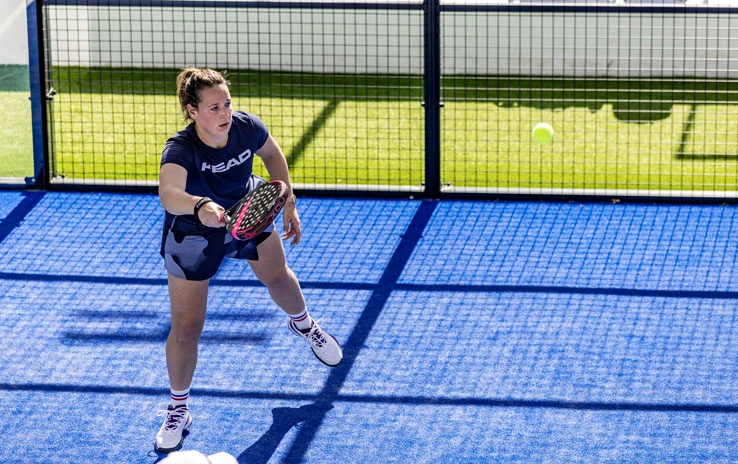Basic padel rules
A begginers guide
If you are a beginner in the game of padel in Malaga, this article is for you. We will present you the basic rules of padel, so you can start playing with confidence and enjoy this fun sport.
You will learn the basic rules of the serve, the point and the fouls, as well as the rules to determine who wins the point and who starts the next point.
Padel is a racquet sport similar to tennis...
… but played on a smaller court enclosed by walls and with slightly different rules. Here are some key points to remember when learning the rules of padel:


Key points to remember when learning the basic rules of padel for begginers:
- The court: Padel is played on a rectangular court that is 20 meters long and 10 meters wide. The playing area is divided by a net into two equal halves, and the court is surrounded by walls on all four sides.
- The ball: Padel is played with a special ball that is slightly smaller and heavier than a tennis ball. Players hit the ball with a racket, and the ball must be served from the right hand service court.
- The serve: The serve is the first shot of a point, and must be hit diagonally across the court to the opponent’s service court. The server must stand within the service box and serve the ball over the net and into the service court. If the ball hits the wall before landing in the service court, it is a fault.
- The rally: After the serve, players take turns hitting the ball back and forth across the net until one player makes a mistake (e.g., hits the ball out of bounds, hits the ball into the net, etc.). The point is then won by the opposing player or team.
- Scoring: Padel uses the same point system as tennis, with points awarded for winning a rally. The player or team that wins six points and has a two-point advantage over the opponent wins the game. A match is typically played to the best of three games.
- Doubles: Padel can be played as singles (one player per team) or doubles (two players per team). In doubles, players on each team stand on opposite sides of the court and take turns hitting the ball.
- Return of serve: In padel, the receiving team must return the serve. The receiving player must allow the ball to bounce before hitting it, unless the serve is hit too low to allow for a bounce. If the receiving team fails to return the serve, the serving team wins the point.
- Let serve: If the serve touches the net and lands in the correct service court, it is a “let serve” and is replayed. If the serve hits the net and lands in the wrong service court, it is a fault.
- Second serve: Players who miss their first serve are allowed a second serve, which must be hit from the left hand service court.
- Volley: In padel, players can hit the ball before it bounces, but they cannot hit volleys (shots hit after the ball has bounced) until it has bounced in their own service court. If a player hits a volley before the ball has bounced in their own service court, it is a fault.
- Out of bounds: If the ball hits the walls or floor outside the playing area, it is out of bounds and the point is awarded to the opposing team. If the ball hits the ceiling, it is a let and the point is replayed.
- Doubles alley: In doubles, there is an area on either side of the court called the “doubles alley.” If the ball lands in the doubles alley, it is in bounds and play continues.
- Let rule: If the ball hits the net and lands in bounds, it is a “let” and the point is replayed. If the ball hits the net and lands out of bounds, it is a fault.
- The switch: In padel, players are allowed to switch positions on the court after each point. This allows players to cover different areas of the court and to vary their shots.
- The no-volley zone: There is a “no-volley zone” on either side of the net, marked by a line that extends 3 meters on either side of the net. Players are not allowed to hit volleys from within the no-volley zone. If a player hits a volley from within the no-volley zone, it is considered a fault.
- The foot fault: Players are not allowed to step on or over the baseline when serving. If a player foot faults, the point is awarded to the opposing team.
- The let cord: If the ball hits the cord of the net and lands in bounds, it is considered a “let” and the point is replayed. If the ball hits the cord and lands out of bounds, it is considered a fault.
- The let rule in doubles: In doubles, if the ball hits the cord of the net and lands in bounds, it is considered a “let” and the point is replayed. If the ball hits the cord and lands out of bounds, it is considered a fault. However, if the ball hits the cord and lands in the doubles alley, it is considered in bounds and play continues.
- The time-out: Players are allowed to take a time-out of up to one minute during a match for any reason.
The basic rules cover aspects such as the size and shape of the playing field, the way the serve is delivered and how it is scored, while the specific rules apply to aspects such as the ball and racket, the game on the net and the rotation of the players on the field of play. In official tournaments, the rules may vary slightly from the basic rules of the game.
- Understand padel rules to enjoy and play properly
- Show respect for this rules and for the other players
- In official tournamentes rules may vary. Knowing the basic rules will help you.
TRC is your social meeting point
Torremuelle Racket Center is the number one place to meet on the Costa Del Sol.
Get fit with Personal trainers, playing padel, tennis or swim in our swimming pool.
Healthy Eating at our snack bar ‘Punto de Oro’.
Receive the best massage or Injury Rehabilitation on the Costa Del Sol.
Come and enjoy the atmosphere with friends or family!
FIND US
- Calle Valle Olímpico, 3. 29631 - Benalmádena
- +34 951 239 000
- info@clubtrc.com
- Monday to Sunday - 09:00 - 23:00
- Torremuelle Racket Center - 2023
TRC is your social club
Come to Torremuelle Racket Center in la Costal del Sol.
You can get fit while playing padel, tennis or swimming.
Eat healthy at our Snack Bar "Punto de Oro".
Above all these things, TRC is your social meeting point.
Come with your family and friends and enjoy!
FIND US
- Calle Valle Olímpico, 3. 29631 - Benalmádena
- +34 951 239 000
- info@torremuelleracketcenter.com
- Monday to Friday - 08:30 - 23:00
- Saturday & Sunday - 09:00 - 23:00
SUBSCRIBE
Be the first to know about all the news at TRC








